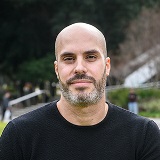Cambridge Healthtech Instituteの第16回年次
Engineering Bispecific and Multifunctional Antibodies
二重特異性抗体・多機能抗体工学
Achieving Unprecedented Efficacy
前例のない有効性の達成
2025年5月15日 - 16日 EDT(米国東部標準時・夏時間)
Scientific Advisory Board
Mahiuddin Ahmed, PhD, President and CSO, VITRUVIAE
Shelley Force Aldred, PhD, CEO, Rondo Therapeutics
Christian Klein, PhD, Cancer Immunotherapy Discovery, Roche Innovation Center Zurich, Roche Pharma Research & Early Development, pRED
G. Jonah Rainey, PhD, Senior Director, Protein Engineering, Eli Lilly and Company
Eugene A. Zhukovsky, PhD, Co-Founder, ZM Scientific Consulting SNC
Sunday, May 11
1:00 pmMain Conference Registration
2:00 pmRecommended Pre-Conference Short Course
SC1: In silico and Machine Learning Tools for Antibody Design and Developability Predictions
*Separate registration required. See short course page for details.
Tuesday, May 13
6:30 pmRecommended Dinner Short Course
SC6: Developability of Bispecific Antibodies
*Separate registration required. See short course page for details.
Thursday, May 15
7:45 amRegistration and Morning Coffee
CONDITIONALLY ACTIVE BISPECIFIC ANTIBODIES
KEYNOTE PRESENTATION: Therapeutic Proteins by Precision Gene Delivery
 Andreas G. Plueckthun, PhD, Professor and Head, Biochemistry, University of Zurich
Andreas G. Plueckthun, PhD, Professor and Head, Biochemistry, University of Zurich
Our SHielded, REtargeted ADenovirus (SHREAD) is based on virus-like particles that are devoid of any viral genes, but contain 36 kb of DNA for multiple genes, can be targeted to any cell type, and are protected from the immune system. We will showcase expression of T cell engagers within the tumor, but also in vivo T cell and dendritic cell targeting for tumor control.
Switchable Bispecific T Cell Nanoengagers for Controllable Cancer Immunotherapy
 Michael Mitchell, PhD, Skirkanich Assistant Professor of Innovation, Department of Bioengineering, University of Pennsylvania
Michael Mitchell, PhD, Skirkanich Assistant Professor of Innovation, Department of Bioengineering, University of Pennsylvania
The broader clinical use of bispecific T cell engagers for inducing anti-tumour toxicity is hindered by their on-target off-tumour toxicity and the associated neurotoxicity and cytokine-release syndrome. Here we show that the off-tumour toxicity of a supramolecular bispecific T cell engager binding to the T cell co-receptor CD3 and to the human epidermal growth factor receptor 2 on breast tumour cells can be halted by disengaging the T cells from the tumour cells via the infusion of the small-molecule drug amantadine, which disassembles the supramolecular aggregate. Supramolecular chemistry may be further leveraged to control the anti-tumour activity and off-tumour toxicity of bispecific antibodies.
Targeted Desialylation and Cytolysis of Tumor Cells by Fusing a Sialidase to a Bispecific T Cell Engager
 Peng Wu, PhD, Professor, Chemical Physiology, Scripps Research Institute
Peng Wu, PhD, Professor, Chemical Physiology, Scripps Research Institute
Bispecific engagers are off-the-shelf agents that recruit endogenous T and NK cells to eradicate tumor cells in a major histocompatibility complex (MHC)-independent manner. However, the promise of BiTE molecules in the treatment of solid tumors has been challenged by antigenic heterogeneity and the immunosuppressive tumor microenvironment (TME). We have developed bispecific engager-sialidase fusion proteins to address these challenges by targeted removal of aberrantly expressed sialoglycans in the TME.
 Directed Luck®: Transposase targeting and Transposon Design Push Expression Beyond Limits
Directed Luck®: Transposase targeting and Transposon Design Push Expression Beyond Limits
 Anneliese Krueger, Scientist, Pharmaceutical Cell Line Development, ProBioGen AG
Anneliese Krueger, Scientist, Pharmaceutical Cell Line Development, ProBioGen AG
Transposases have eased cell line development. Taking this concept to a new level, we equipped our hyperactive transposase with epigenetic readers that targets highly active genomic sites in the host cell line and designed advanced transposons with optimized ITRs for most efficient and clean integration. DirectedLuck® delivers highly productive clones and bulk pools ready for manufacturing and is particularly suited for heterodimeric formats, polyclonal antibody cell lines and viral vector packaging cell lines.
10:30 amCoffee Break in the Exhibit Hall with Poster Viewing
11:15 amTransition to Plenary Fireside Chat
PLENARY FIRESIDE CHAT
Riding the Next Biotech Wave-Trends in Biotech Investments, Partnering, and M&As
 Jakob Dupont, MD, Executive Partner, Sofinnova Investments
Jakob Dupont, MD, Executive Partner, Sofinnova Investments
- Emerging Biotherapeutic Modalities, Technologies and Innovations- ADCs, radiopharmaceuticals, GLP-1, AI, machine learning, and other exciting trends to watch
- Introduction to different strategies for investments, M&As, partnering, licensing etc.
- Investing in platforms versus assets
- Advice on funding options for start-ups, early to late stage clinical programs, etc.
12:25 pmLuncheon in the Exhibit Hall and Last Chance for Poster Viewing
NOVEL MECHANISMS OF ACTION
Leveraging Bispecific Antibodies with Cellular Targeting and a Tag-Binding Domain Enables the Attachment of Cargo to an Antibody via a Peptide Tag
 Sara M. Mangsbo, PhD, Professor, Pharmacy, Uppsala University
Sara M. Mangsbo, PhD, Professor, Pharmacy, Uppsala University
We have developed a bispecific antibody-conjugate platform to enhance the multifunctional capabilities of antibodies. Several bispecific antibodies targeting CD20, HER2, and CD40 have been produced to enable a versatile antibody/drug conjugate tool via a simple mixing step. We have studied drug conjugates based on peptide and oligonucleotides-based cargoes using this technology and have investigated conjugate stability and its impact on in vitro and in vivo drug efficacy.
SECOND-GEN T CELL ENGAGERS: NEW APPROACHES AND NEW DESIGNS
Addressing the Limitations of Cell Engagers via Protein Geometry, Receptor Selection, and Cytokine Inclusion
 Brian A. Rabinovich, PhD, CSO, R&D, Fuse Biotherapeutics
Brian A. Rabinovich, PhD, CSO, R&D, Fuse Biotherapeutics
Cell engagers are often detuned to reduce the risk of toxicity. This strategy can sacrifice the magnitude of cytotoxicity and addresses neither cell fitness nor response durability. Simultaneous adjustment of cell engager synaptic distance and apparent affinity for targets allows for optimization of signal strength to establish a “cytokine window” at maximum cytotoxicity. Such engagers support the inclusion of functionally specific cytokines that promote proliferation, oppose functional exhaustion, and facilitate the targeting of small lymphocyte populations with inherent abilities to distinguish normal from diseased cells.
Next Generation T Cell Engagers with Embedded Autoregulation (AR)
 Vincent Muczynski, PhD, Director, NovalGen
Vincent Muczynski, PhD, Director, NovalGen
Major progress in the field of T cell redirecting therapies have contributed to the successful development of T cell engager (TCEs) and the recent approval of several molecules for haematological malignancies and solid tumours. However, this class of therapies is still associated with challenges limiting their widespread use, including risk of high-grade toxicity requiring specialized management, as well as potential long-term exhaustion of the T cell population. Autoregulation (AR) provides an embedded mechanism that enables the specific inactivation of TCEs when there is a risk of T cell overactivation to limit T cell stimulation and preserve function. This has led to the development of next generation of TCEs with an improved therapeutic index due to a safer, more efficacious profile.
4:00 pmNetworking Refreshment Break
Synergizing Allogeneic T Cells with Bispecific Antibodies for Enhanced Anti-Tumor Responses
 Riyaz Khan, PhD Candidate, T Cell Therapies, ETH Zurich
Riyaz Khan, PhD Candidate, T Cell Therapies, ETH Zurich
This talk will explore the use of engineered allogeneic T cells in enhancing bispecific antibody (biAb) cancer immunotherapy. By decoupling T cell receptor (TCR) binding from CD3 signaling, we maintain biAb-driven T cell activation while preventing harmful alloreactive responses. In a CD19+ tumor model, these engineered T cells, combined with the biAb blinatumomab, demonstrated effective tumor clearance without detectable alloreactivity, highlighting a promising approach for ‘off-the-shelf’ T cell therapies.
NON-TRADITIONAL BUILDING BLOCKS FOR ENGINEERING MULTISPECIFIC ANTIBODIES
Multispecific Antibodies Utilizing Shark-Derived VNAR Binding Domains
 Helen Dooley, PhD, Associate Professor, Microbiology and Immunology, University of Maryland, Baltimore
Helen Dooley, PhD, Associate Professor, Microbiology and Immunology, University of Maryland, Baltimore
Like camelids, sharks produce a heavy chain isotype, IgNAR. The variable domains of shark IgNAR, so called VNARs, are structurally more similar to TCR and Ig light chain variable regions than those of Ig heavy chains. The highly diverse structural repertoire created by the presence of 4 CDR/hypervariable loops allows VNARs to bind in unique ways and access epitopes unrecognized by conventional Igs or, for some targets, camelid VHHs. We will discuss how we are exploiting the novel binding modalities of VNARs obtained from immunized nurse sharks to generate bispecific and multispecific antibodies with extended binding profiles and improved function.
Grabbing the Bull by the Horns: Engineering Options of Cattle-Derived Ultralong CDR-H3 Paratopes for the Generation of Novel Multifunctional Antibody Architectures
 Stefan Zielonka, PhD, Senior Director, Global Head of Antibody Discovery and Protein Engineering (ADPE) Research and Development, Merck Healthcare KGaA; Professor, Biomolecular Immunotherapy, Technische Universität Darmstadt
Stefan Zielonka, PhD, Senior Director, Global Head of Antibody Discovery and Protein Engineering (ADPE) Research and Development, Merck Healthcare KGaA; Professor, Biomolecular Immunotherapy, Technische Universität Darmstadt
A subset of bovine antibodies displays a peculiarly long CDR-H3 which is composed of a stalk and a knob region. Importantly, the knob is primarily responsible for antigen binding. We have harnessed this specific diversity for the generation of mono- and multispecific antibody derivatives and also generated a novel symmetric bispecific antibody format by introducing the knob paratope into the CH3 domain of the Fc part of an IgG.
6:00 pmClose of Day
Friday, May 16
7:15 amRegistration Open
INTERACTIVE DISCUSSIONS
Interactive Discussions are informal, moderated discussions, allowing participants to exchange ideas and experiences and develop future collaborations around a focused topic. Each discussion will be led by a facilitator who keeps the discussion on track and the group engaged. To get the most out of this format, please come prepared to share examples from your work, be a part of a collective, problem-solving session, and participate in active idea sharing. Please visit the Interactive Discussions page on the conference website for a complete listing of topics and descriptions.
Next-Generation T Cell Engagers (TCEs)
Vincent Muczynski, PhD, Director, NovalGen
The principle of a bispecific antibody targeting CD3 to redirect cytotoxic T cells toward a tumor target has undeniably contributed to the success of T cell engagers and led to the recent approval of several molecules showing undisputed efficacy in both haematological malignancies and solid tumours. A broad range of research programs are now looking at ways to enhance the potential of these molecules and develop next-generation TCEs.
- New technologies to optimize the balance between efficacy and adverse events
- Harnessing multispecific antibody formats for enhanced efficacy/specificity
- Maximizing the efficiency of TCEs in the solid tumor microenvironment?
BREAKOUT DISCUSSION: Safety Switches for T-Cell Engagers
Noor Momin, PhD, Assistant Professor, University of Pennsylvania
- Design parameters and objectives for T cell engagers
- Engineering strategies to improve their on-target (correct receptor) on-tissue (correct localization)
- Engineering strategies to reduce their on-target (correct receptors) off-tissue (wrong tissue localization)
- Considerations for the timing, reversibility, and translation of these approaches
BISPECIFICS FOR ONCOLOGY
KEYNOTE PRESENTATION: Multispecific T Cell Engagers for the Treatment of Hematological Malignancies
 Ulrike Philippar, PhD, Senior Director and Head, Oncology and Discovery Hematological Malignancies, Johnson & Johnson Innovative Medicine
Ulrike Philippar, PhD, Senior Director and Head, Oncology and Discovery Hematological Malignancies, Johnson & Johnson Innovative Medicine
Within the past decade, therapies that activate/engage T cells have changed the landscape of treatment of hematological malignancies. Successful T cell-engaging antibodies target antigens selectively expressed on tumors with minimal/no expression in other tissues and eliminate malignant cells resulting in long-term clinical benefit. Several bispecific T cell engagers have been approved in hematological malignancies. Recent research evaluates trispecific T cell engagers targeting two tumor-associated antigens in multiple myeloma/lymphoma.
SAIL66-A Next-Generation T Cell Engager Targeting CLDN-Potentiates Efficacy by Binding to CD3/CD137
 Takayuki Kamikawa, Scientific Researcher, Discovery Research, Chugai Pharmaceutical Co Ltd.
Takayuki Kamikawa, Scientific Researcher, Discovery Research, Chugai Pharmaceutical Co Ltd.
Conventional T cell engagers (TCEs) for solid tumors face challenges of “on-target, off-tumor toxicity” and T cell dysfunction by CD3 activation alone. The newly developed SAIL66, a trispecific antibody targeting CLDN6/CD3/CD137, adopts a proprietary Dual-Ig to activate both of CD3 and CD137. Our CLDN6 specific Fab and the Dual-Ig platform with unique binding mode enabling superior T cell activation and potent anti-tumor effects to conventional TCEs.
Bispecific Dendritic-T Cell Engager Potentiates Anti-Tumor Immunity
 Rony Dahan, PhD, Principal Investigator, Immunology, Weizmann Institute of Science
Rony Dahan, PhD, Principal Investigator, Immunology, Weizmann Institute of Science
This presentation discusses the pivotal role of dendritic-T cell crosstalk in driving anti-tumor immunity and enhancing immunotherapy. I will highlight our recent studies that led to the development of new immunotherapies, harnessing dendritic cell-T cell interactions for optimal efficacy.
10:30 amNetworking Coffee Break
EVOLVE: A Novel CD2 Costimulatory T Cell Engager Platform
 Jeremy S. Myers, PhD, Senior Vice President, R&D, EvolveImmune Therapeutics Inc.
Jeremy S. Myers, PhD, Senior Vice President, R&D, EvolveImmune Therapeutics Inc.
CD3 bispecific T cell engagers redirect a patient's T cells to cancer cells and have emerged as a therapeutic strategy for the treatment of diverse cancers with 10 drug approvals, 9 approvals since 2022, including 2 approvals in solid tumors. Recent preclinical and clinical studies have identified strategies to utilize T cell costimulation to optimize T cell engager-induced anti-tumor immunity. EVOLVE integrates proprietary light-chain pairing, CD2 and CD3 affinity-tuned agonism to deliver potent tumor killing with balanced cytokine release in a highly developable platform.
USING AI AND COMPUTATIONAL MODELS IN THE DISCOVERY, OPTIMIZATION, AND DEVELOPMENT OF BISPECIFICS
Understanding the Targeting Mechanisms of Multispecific Biologics in Immunotherapy with Multiscale Modeling
 Yinghao Wu, PhD, Associate Professor, Systems and Computational Biology, Albert Einstein College of Medicine
Yinghao Wu, PhD, Associate Professor, Systems and Computational Biology, Albert Einstein College of Medicine
The design of bispecific fusion proteins is a central challenge for the realization of new immunotherapeutic strategies. We developed a multi-scale computational framework to understand how bispecific fusion proteins target surface-bound membrane receptors. We found that proteins with long and flexible linkers are more efficient in targeting receptors.
AND-Body Medicines: Programmed Biologics That Enable More Efficacious and Better Tolerated Medicines
 Daniel Blom, PhD, CSO, R&D, Ampersand Biomedicines
Daniel Blom, PhD, CSO, R&D, Ampersand Biomedicines
The development of therapeutic molecules is often limited by insufficient on-target efficacy and adverse effects related to on-target, off-tissue activity. Ampersand has developed a computationally powered drug-discovery approach that has identified tissue-specific addresses that in turn has enabled the generation of a new type of programmable biologic. The resulting AND-Body Therapeutics are designed to specifically target the site of disease and conditionally actuate biology after localizing, thus sparing healthy tissue or cells. AND-Body molecules have a significantly improved therapeutic index when compared to non-targeted medicines, making them an attractive modality to address new targets for the treatment of a multitude of different diseases.
A Novel Bivalent Bispecific Antibody Format for Infectious Diseases
 Xiuling Li, PhD, Associate Director, Novel Multispecific Modalities, AstraZeneca
Xiuling Li, PhD, Associate Director, Novel Multispecific Modalities, AstraZeneca
The majority of bispecific IgG molecules reported so far are asymmetric format that have monovalent binding on each epitope. We developed a novel bivalent bispecific antibody with a native IgG-like structure containing four Fabs that enhances binding avidity compared to traditional monovalent bispecific. This presentation will focus on the engineering, developability and applications of bivalent bispecifics in infectious diseases
12:30 pmClose of Summit
* 不測の事態により、事前の予告なしにプログラムが変更される場合があります。
アジェンダ・講演者・スポンサー更新
2025年 プログラム
表示する:

工学ストリーム

腫瘍ストリーム

多重特異性ストリーム

免疫療法ストリーム

発現ストリーム

分析法ストリーム

免疫原性ストリーム

新興治療ストリーム

機械学習ストリーム


 Talk Title to be Announced
Talk Title to be Announced




 Talk Title to be Announced
Talk Title to be Announced

 Talk Title to be Announced
Talk Title to be Announced












